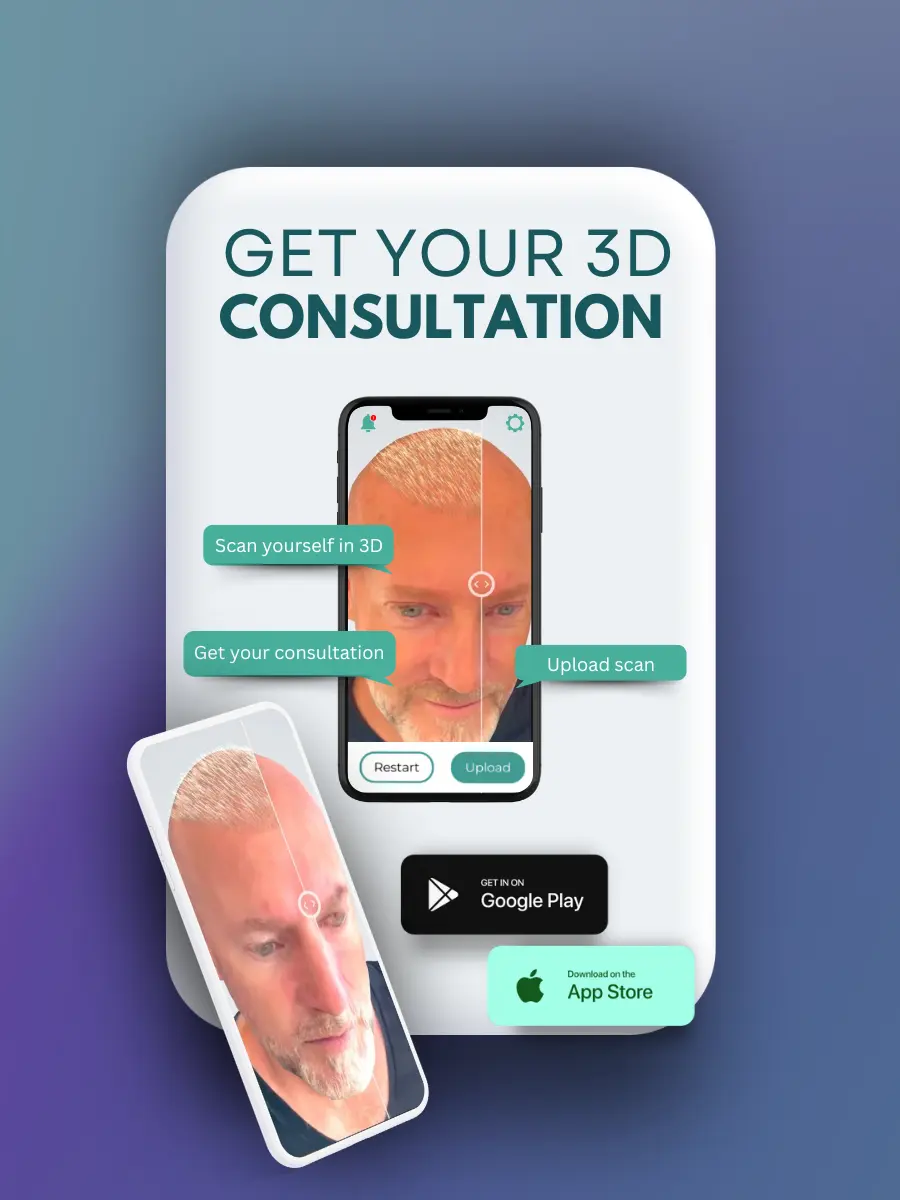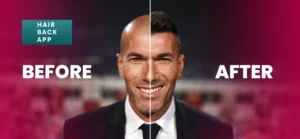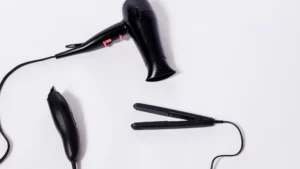Eyebrow hair loss, medically known as madarosis, can occur due to various factors, ranging from hormonal imbalances to excessive grooming practices. This condition not only affects one’s appearance but can also lead to a loss of confidence and self-esteem.
Understanding the root causes of eyebrow hair loss is crucial in addressing this concern effectively. Eyebrows play a pivotal role in framing the face and enhancing facial expressions.
Beyond their practical function of protecting the eyes from debris and sweat, eyebrows are essential in conveying emotions and defining one’s unique facial features. However, despite their significance, many individuals experience the distressing issue of eyebrow hair loss.
My name is Emma Wright, your resident hair transplant and restoration specialist. In this article, we’ll be looking at the diverse causes of eyebrow hair loss and provide insights into effective prevention and management strategies.
Let’s get started!
Causes of Eyebrow Hair Loss
Eyebrow hair loss can stem from a variety of factors, each with its own unique impact on hair growth patterns. Here are some main elements that have been marked to be causes of hair loss in the eyebrow.
1. Hormonal Imbalance
Hormonal fluctuations play a significant role in regulating various bodily functions, including hair growth. When hormonal balance is disrupted, it can adversely affect the growth cycle of eyebrow hairs, leading to thinning or loss.
Hormones such as estrogen, testosterone, and thyroid hormones influence the growth phase, transition phase, and resting phase of hair follicles. Imbalances in these hormones can disrupt the normal cycle, resulting in eyebrow hair loss.
Specific Hormonal Conditions Linked to Eyebrow Hair Loss
- Thyroid Disorders: Conditions like hypothyroidism (underactive thyroid) or hyperthyroidism (overactive thyroid) can disrupt hormone levels, leading to changes in hair texture and density, including the eyebrows.
- Menopause: Menopausal hormonal shifts, particularly the decline in estrogen levels, can contribute to eyebrow hair thinning and loss in women.
2. Nutritional Deficiencies
Adequate nutrition is essential for maintaining the health of not just the body but also the hair, including eyebrow hair. Nutritional deficiencies can significantly impact eyebrow health, leading to thinning or loss of hair.
Nutrients play a vital role in supporting the growth and strength of hair follicles. When the body lacks essential vitamins, minerals, and proteins, eyebrow hairs may become brittle, weak, and more prone to breakage or shedding. This can result in noticeable thinning or gaps in the eyebrows.
Key Nutrients Crucial for Hair Growth
- Vitamin A: Necessary for cell growth and differentiation, vitamin A helps maintain the health of hair follicles and promotes the production of sebum, which moisturizes the scalp and keeps hair hydrated.
- Vitamin C: An antioxidant vitamin, vitamin C supports collagen production, which is vital for hair structure and strength. It also aids in the absorption of iron, another essential nutrient for hair growth.
- Vitamin E: Known for its antioxidant properties, vitamin E helps protect hair follicles from oxidative stress and damage. It also improves blood circulation to the scalp, promoting healthier hair growth.
- Biotin: Also known as vitamin B7 or H, biotin is crucial for the synthesis of keratin, a protein that forms the structural foundation of hair. Biotin deficiency has been linked to hair loss and thinning, making it an important nutrient for maintaining eyebrow health.
3. Overplucking and Excessive Grooming
Overzealous grooming practices, such as overplucking and using harsh chemicals, can inadvertently damage the delicate hair follicles in the eyebrows, leading to eyebrow hair loss.
How Aggressive Grooming Practices Damage Hair Follicles
- Overplucking: When eyebrows are excessively plucked, the hair follicles can become damaged or traumatized. This repeated trauma can disrupt the natural growth cycle of the hairs, leading to sparse or uneven eyebrows over time.
- Harsh Chemicals: Some grooming products, such as eyebrow dyes or harsh cleansers, contain chemicals that can irritate the skin and weaken the hair follicles. Prolonged exposure to these chemicals can result in eyebrow hair breakage or premature shedding.
Common Grooming Habits Leading to Eyebrow Hair Loss
- Overplucking: Tweezing or waxing eyebrows too frequently or aggressively can cause thinning or gaps in the eyebrows.
- Use of Harsh Products: Applying harsh cleansers, exfoliants, or eyebrow dyes without proper precautions can irritate the skin and damage the hair follicles.
- Incorrect Technique: Using improper grooming tools or techniques, such as using dull tweezers or pulling hairs in the wrong direction, can lead to follicle damage and subsequent hair loss.
Medical Conditions Associated with Eyebrow Hair Loss
Several medical conditions can contribute to eyebrow hair loss, ranging from autoimmune disorders to skin conditions affecting the hair follicles.
Overview of Medical Conditions
- Alopecia Areata: An autoimmune condition where the immune system mistakenly attacks hair follicles, leading to sudden hair loss, including in the eyebrows.
- Eczema (Atopic Dermatitis): A chronic skin condition characterized by inflammation and itching, eczema can affect the eyebrows and lead to hair loss due to scratching and irritation of the skin.
- Hypothyroidism: An underactive thyroid gland can cause hormonal imbalances that result in eyebrow thinning or loss as one of its symptoms.
How These Conditions Affect Hair Follicles
- Autoimmune Disorders: Conditions like alopecia areata cause the immune system to target and attack hair follicles, resulting in hair loss.
- Skin Conditions: Inflammatory skin conditions like eczema can disrupt the normal function of hair follicles, leading to inflammation and potential scarring that interferes with hair growth.
- Hormonal Imbalances: Medical conditions such as hypothyroidism can affect hormone levels, disrupting the natural growth cycle of hair follicles and leading to hair loss, including in the eyebrows.

Treatment Options for Eyebrow Hair Loss
Discovering effective hair loss treatment options for eyebrow hair loss is essential for restoring confidence and achieving fuller, healthier eyebrows. Let’s explore various approaches that can help address this common concern and promote eyebrow regrowth.
Topical Treatments for Eyebrow Hair Loss
Topical treatments offer a non-invasive approach to promoting eyebrow regrowth and addressing hair loss concerns. Among the popular options are minoxidil and corticosteroid creams, which have shown efficacy in stimulating hair growth in various areas, including the eyebrows.
How These Treatments Stimulate Hair Growth
- Minoxidil: This over-the-counter topical solution works by widening blood vessels and opening potassium channels, which may promote hair growth by extending the growth phase of hair follicles. When applied to the eyebrows consistently, minoxidil can help revitalize dormant follicles and encourage new hair growth.
- Corticosteroid Creams: These prescription-strength creams contain corticosteroids, which have anti-inflammatory properties that can help reduce inflammation around the hair follicles. By alleviating inflammation, corticosteroid creams create a more favorable environment for hair growth and may help address eyebrow hair loss associated with conditions like alopecia areata or eczema.
Microblading and Cosmetic Procedures for Eyebrow Hair Loss
Microblading and other cosmetic procedures offer temporary solutions for individuals seeking to enhance the appearance of their eyebrows. These techniques involve the application of pigments to mimic the appearance of natural eyebrow hairs, providing a fuller and more defined look.
Procedure Process
- Microblading: During microblading, a trained technician uses a handheld tool with fine needles to create small, hair-like strokes on the brow area. The pigment is deposited into the superficial layers of the skin, resulting in semi-permanent eyebrow enhancements that typically last one to three years.
- Cosmetic Tattooing: Alternative techniques such as eyebrow tattooing or powder brows involve the use of a tattoo machine to implant pigment into the skin, creating a filled-in eyebrow appearance. These procedures can offer longer-lasting results compared to microblading but may require more frequent touch-ups.
Potential Risks
- Infection: Improper sterilization of equipment or inadequate aftercare can increase the risk of infection following cosmetic procedures, leading to complications such as inflammation or scarring.
- Allergic Reactions: Some individuals may experience allergic reactions to the pigments used in microblading or cosmetic tattooing, resulting in irritation, swelling, or itching in the treated area.
- Unsatisfactory Results: Despite meticulous technique, there is a possibility of dissatisfaction with the outcome of cosmetic procedures, particularly if the final appearance does not meet expectations or if pigment fading occurs unevenly.
Lifestyle Changes to Prevent Eyebrow Hair Loss
In addition to medical treatments and cosmetic procedures, making certain lifestyle changes can play a crucial role in managing and preventing eyebrow hair loss. By addressing underlying factors contributing to hair loss and promoting overall well-being, individuals can support the health and vitality of their eyebrows.
Importance of Lifestyle Factors
- Nutrition: A balanced diet rich in essential vitamins, minerals, and proteins is vital for maintaining healthy hair follicles and promoting robust eyebrow growth. Nutrients like vitamins A, C, E, and biotin are particularly beneficial for hair health and can be obtained from a variety of foods, including fruits, vegetables, lean proteins, and whole grains.
- Stress Management: Chronic stress can disrupt hormone levels and contribute to hair loss, including in the eyebrows. Incorporating stress-reduction techniques such as meditation, yoga, or deep breathing exercises into daily routines can help manage stress levels and support overall hair health. A prompt and consistent rest can help you solve any stress-induced hair loss in your eyebrow.
- Gentle Grooming Practices: Avoiding aggressive grooming habits such as overplucking or using harsh chemicals on the eyebrows can prevent damage to the hair follicles and minimize the risk of eyebrow hair loss. Opt for gentle grooming tools and techniques to maintain eyebrow shape without causing undue stress on the hair.
Tips for Maintaining a Healthy Lifestyle
- Eat a Balanced Diet: Focus on incorporating nutrient-dense foods into your meals, including plenty of fruits, vegetables, lean proteins, and healthy fats.
- Stay Hydrated: Drink an adequate amount of water throughout the day to keep the body and hair follicles hydrated and functioning optimally.
- Get Regular Exercise: Engage in regular physical activity to improve circulation, reduce stress levels, and support overall well-being.
- Prioritize Sleep: Aim for seven to eight hours of quality sleep each night to allow the body to repair and regenerate, including the hair follicles.
Preventing Eyebrow Hair Loss
Maintaining the fullness and shape of your eyebrows is not only essential for aesthetic reasons but also contributes to framing your face and expressing your unique personality. While various factors can contribute to eyebrow hair loss, adopting preventive measures can help preserve the health and vitality of your eyebrows.
By implementing lifestyle changes, practicing gentle grooming techniques, and addressing underlying medical conditions, you can minimize the risk of eyebrow hair loss and promote long-term eyebrow health. Let’s unravel some effective strategies for preventing eyebrow hair loss and achieving fuller, more defined brows.
Proper Grooming Techniques to Prevent Eyebrow Hair Loss
Gentle grooming practices are crucial for maintaining the health and integrity of your eyebrow hair follicles. By adopting the right techniques and using appropriate tools and products, you can minimize the risk of damage and promote healthy eyebrow growth.
Tips for Gentle Grooming Practices
- Limit Plucking Frequency: Resist the temptation to overpluck your eyebrows. Instead, allow them to grow out naturally and only remove stray hairs as needed to maintain your desired shape.
- Use Sharp, Precision Tweezers: Opt for high-quality tweezers with fine, sharp tips to target individual hairs with precision. Dull or low-quality tweezers can cause unnecessary pulling and trauma to the hair follicles.
- Avoid Harsh Chemicals: Steer clear of eyebrow dyes or harsh cleansers that contain irritating ingredients. Opt for gentle, fragrance-free products specifically formulated for sensitive skin to minimize the risk of inflammation or damage to the follicles.
- Moisturize and Condition: Keep your eyebrow hairs hydrated and nourished by applying a lightweight, non-comedogenic moisturizer or eyebrow serum. This helps prevent dryness and breakage while promoting healthy hair growth.
Tools and Products for Eyebrow Care
- Spoolie Brush: Use a clean spoolie brush to groom your eyebrows and distribute any applied products evenly. Brushing your eyebrows in the direction of hair growth helps maintain their shape and prevents hairs from becoming tangled or misaligned.
- Eyebrow Scissors: Trim any excessively long or unruly eyebrow hairs with small, sharp scissors designed specifically for eyebrow grooming. Trim carefully to avoid cutting too much hair and causing sparse areas.
- Gentle Cleanser: Choose a mild, sulfate-free cleanser to remove dirt, oil, and makeup from your eyebrows without stripping away natural oils or irritating the skin.
Balanced Diet and Supplements for Healthy Eyebrows
Nutrition plays a critical role in maintaining the health and vitality of your eyebrows. By fueling your body with essential vitamins, minerals, and nutrients, you can support optimal hair growth and prevent eyebrow hair loss.
Emphasis on Nutrition for Healthy Eyebrows
- Vitamin A: Found in foods like sweet potatoes, carrots, and leafy greens, vitamin A promotes the production of sebum, an oily substance that moisturizes the scalp and keeps eyebrow hairs healthy.
- Vitamin C: Citrus fruits, strawberries, and bell peppers are excellent sources of vitamin C, which aids in collagen production and supports the strength and resilience of hair follicles.
- Vitamin E: Incorporate foods rich in vitamin E, such as almonds, sunflower seeds, and spinach, to protect your eyebrows from oxidative stress and promote blood circulation to the follicles.
- Biotin: Boost your biotin intake with foods like eggs, nuts, and whole grains, or consider taking a biotin supplement to support keratin production and encourage eyebrow growth.
Suggestions for Nutrient-Rich Foods and Supplements
- Omega-3 Fatty Acids: Incorporate sources of omega-3 fatty acids, such as salmon, walnuts, and flaxseeds, into your diet to nourish your eyebrows from within and promote healthy hair growth.
- Protein: Ensure an adequate intake of protein from sources like lean meats, beans, and lentils to provide the building blocks necessary for strong and resilient eyebrow hairs.
- Iron: Iron-rich foods like lean red meat, spinach, and lentils help prevent iron deficiency anemia, which can contribute to hair loss and thinning eyebrows.
Regular Monitoring and Consultation for Eyebrow Hair Loss
Regular monitoring of your eyebrow health and seeking professional advice are essential components of proactive eyebrow care. By staying vigilant and consulting with dermatologists or trichologists when necessary, you can identify potential issues early and explore appropriate treatment options.
Importance of Professional Consultation
- Early Detection: Regular check-ups with dermatologists or trichologists allow for the early detection of eyebrow hair loss or underlying medical conditions that may contribute to hair thinning.
- Personalized Treatment Plans: Professionals can assess your eyebrow health and provide personalized treatment recommendations tailored to your specific needs and concerns.
- Monitoring Progress: Professionals can track your progress over time and adjust treatment plans as needed to ensure optimal results and long-term eyebrow health.
Encouragement for Regular Check-ups
- Frequency: Schedule regular check-ups with dermatologists or trichologists, especially if you notice changes in your eyebrow health or experience sudden hair loss.
- Open Communication: Be proactive in discussing any concerns or questions you may have about your eyebrow health during consultations, and follow through with recommended treatments or lifestyle changes.
Conclusion
In conclusion, maintaining healthy and full eyebrows is not only essential for aesthetic reasons. But it also contributes to framing the face and expressing one’s unique personality.
If you’re experiencing eyebrow hair loss, know that you’re not alone, and there are solutions available to help you regain confidence in your appearance. Exploring suitable options and taking action can lead to noticeable improvements in eyebrow health and overall well-being.
Don’t hesitate to reach out to dermatologists, trichologists, or other qualified professionals for guidance and support on your journey to healthier eyebrows. With dedication and perseverance, you can overcome eyebrow hair loss and enjoy the beauty of full, vibrant brows once again.














